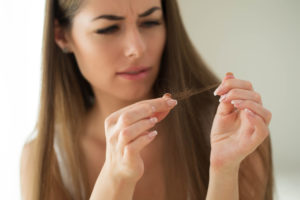For those of us in the ongoing hair loss battle, there’s never a shortage of medicinal offerings that promise to free us from the fight for our follicles. From FDA-approved minoxidil (Rogaine), to more advanced treatments, such as PRP (platelet rich plasma) and FDA-approved Olumiant, the options for putting an end to our hair loss woes are many.
But how do we decide which treatment is most effective for our condition?

Can Olumiant Cure My Alopecia Areata?
In June 2022 the FDA approved the prescription oral medication baricitinib (marketed as Olumiant) for severe alopecia areata. A JAK inhibitor, it “regrows hair by blocking the immune system from attacking hair follicles,” and is considered more effective than minoxidil and PRP. A topical solution applied to the scalp, it can help stimulate hair growth by inhibiting the hair-loss hormone DHT. But it doesn’t come without side effects and can also be costly. The drug can cause respiratory and urinary tract infections, can increase risk of lymphoma and skin cancers, and costs over $2500 for a 30-day supply.
How Does Platelet Rich Plasma Help My Hair Loss?
PRP, or platelet-rich plasma, while not yet FDA-approved, is increasing in popularity for US dermatologists and medical practitioners as a viable hair-loss treatment. Administered by a doctor or other qualified medical professional, PRP uses a patient’s own blood. The blood platelets are separated through a centrifugal process and then injected back into the patient’s scalp. Studies show that patients achieved hair growth in approximately 6 months. The caveat though is that hair growth is directly related to the health of the patient’s own blood platelets level—lower platelet levels can result in the treatment being less effective. And while hair growth rates appear higher with PRP versus minoxidil, undergoing PRP treatment is not without some risks. Some patients can experience blood vessel or nerve injury, scar tissue, or side effects from the anesthesia used during the procedure.
Rogaine vs. Propecia: Is One Better Than The Other?
While it’s always important to keep our medical professionals updated on any stage of our hair loss, some of us are opting to manage our hair-loss treatments at home. Rogaine, for men (5% formula) and women (2% formula), is available just about anywhere and doesn’t require a prescription. While it won’t regrow hair, it can arrest the hair loss process when used long-term, but you’ve got to be committed to ongoing use—once you stop using the medication you lose any hair the product has generated. Hair supplements like Viviscal and Nutrafol are also an at-home option, but must be taken orally and are not FDA-approved.
And men using Rogaine can go a step further in regaining their hair if they opt for the addition of prescription oral finasteride (also known as Propecia) to their hair loss treatment regimen. Finasteride can be used in conjunction with Rogaine to promote hair growth. Like Oluminant, it suppresses the development of DHT, making hair growth in places like the forehead and crown possible. You’ve likely heard of products like Hims, Happy Head, and Keeps, which all use the rogaine-finasteride combination.
So What’s the Cure For Me?
So, with all these options, which one is best? It all comes down to the tried-and-true advice we hair loss warriors have been given for years: talk to your medical professional and create a plan that works for you! Not every solution works for everybody. And your concern should be the most important body in your life: yours.


